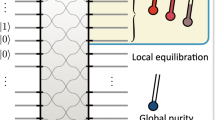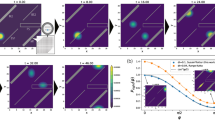Abstract
Advances in control techniques for vibrational quantum states in molecules present new challenges for modelling such systems, which could be amenable to quantum simulation methods. Here, by exploiting a natural mapping between vibrations in molecules and photons in waveguides, we demonstrate a reprogrammable photonic chip as a versatile simulation platform for a range of quantum dynamic behaviour in different molecules. We begin by simulating the time evolution of vibrational excitations in the harmonic approximation for several four-atom molecules, including H2CS, SO3, HNCO, HFHF, N4 and P4. We then simulate coherent and dephased energy transport in the simplest model of the peptide bond in proteins—N-methylacetamide—and simulate thermal relaxation and the effect of anharmonicities in H2O. Finally, we use multi-photon statistics with a feedback control algorithm to iteratively identify quantum states that increase a particular dissociation pathway of NH3. These methods point to powerful new simulation tools for molecular quantum dynamics and the field of femtochemistry.
This is a preview of subscription content, access via your institution
Access options
Access Nature and 54 other Nature Portfolio journals
Get Nature+, our best-value online-access subscription
$29.99 / 30 days
cancel any time
Subscribe to this journal
Receive 51 print issues and online access
$199.00 per year
only $3.90 per issue
Buy this article
- Purchase on Springer Link
- Instant access to full article PDF
Prices may be subject to local taxes which are calculated during checkout




Similar content being viewed by others
References
Gatti, F. Molecular Quantum Dynamics. (Springer, Berlin, 2014).
Brif, C., Chakrabarti, R. & Rabitz, H. Control of quantum phenomena: past, present and future. New J. Phys. 12, 075008 (2010).
Feynman, R. P. Simulating physics with computers. Int. J. Theor. Phys. 21, 467–488 (1982).
Lloyd, S. Universal quantum simulators. Science 273, 1073–1078 (1996).
Aspuru-Guzik, A. & Walther, P. Photonic quantum simulators. Nat. Phys. 8, 285–291 (2012).
Georgescu, I. M., Ashhab, S. & Nori, F. Quantum simulation. Rev. Mod. Phys. 86, 153–185 (2014).
Shi, S., Woody, A. & Rabitz, H. Optimal control of selective vibrational excitation in harmonic linear chain molecules. J. Chem. Phys. 88, 6870–6883 (1988).
Shapiro, M. & Brumer, P. Coherent control of molecular dynamics. Rep. Prog. Phys. 66, 859–942 (2003).
Assion, A. et al. Control of chemical reactions by feedback-optimized phase-shaped femtosecond laser pulses. Science 282, 919–922 (1998).
Hause, M. L., Yoon, Y. H. & Crim, F. F. Vibrationally mediated photodissociation of ammonia: the influence of NH stretching vibrations on passage through conical intersections. J. Chem. Phys. 125, 174309 (2006).
Brinks, D. et al. Visualizing and controlling vibrational wave packets of single molecules. Nature 465, 905–908 (2010).
Alnaser, A. et al. Subfemtosecond steering of hydrocarbon deprotonation through superposition of vibrational modes. Nat Commun. 5, 3800 (2014).
Tong, X., Winney, A. H. & Willitsch, S. Sympathetic cooling of molecular ions in selected rotational and vibrational states produced by threshold photoionization. Phys. Rev. Lett. 105, 143001 (2010).
Wolter, B. et al. Ultrafast electron diffraction imaging of bond breaking in di-ionized acetylene. Science 354, 308–312 (2016).
Clark, J. B., Lecocq, F., Simmonds, R. W., Aumentado, J. & Teufel, J. D. Sideband cooling beyond the quantum backaction limit with squeezed light. Nature 541, 191–195 (2017).
Dorfman, K. E., Schlawin, F. & Mukamel, S. Nonlinear optical signals and spectroscopy with quantum light. Rev. Mod. Phys. 88, 045008 (2016).
Karpiński, M., Jachura, M., Wright, L. J. & Smith, B. J. Bandwidth manipulation of quantum light by an electro-optic time lens. Nat. Photon. 11, 53–57 (2017).
Aaronson, S. & Arkhipov, A. The computational complexity of linear optics. Theor. Comput. 9, 143–252 (2013).
Berry, D. W., Childs, A. M., Cleve, R., Kothari, R. & Somma, R. D. Simulating Hamiltonian dynamics with a truncated Taylor series. Phys. Rev. Lett. 114, 090502 (2015).
Lanyon, B. P. et al. Universal digital quantum simulation with trapped ions. Science 334, 57–61 (2011).
Kassal, I., Jordan, S. P., Love, P. J., Mohseni, M. & Aspuru-Guzik, A. Polynomial-time quantum algorithm for the simulation of chemical dynamics. Proc. Natl Acad. Sci. USA 105, 18681–18686 (2008).
Lidar, D. A. & Wang, H. Calculating the thermal rate constant with exponential speedup on a quantum computer. Phys. Rev. E 59, 2429–2438 (1999).
Campbell, E. T., Terhal, B. M. & Vuillot, C. Roads towards fault-tolerant universal quantum computation. Nature 549, 172–179 (2017).
Wecker, D., Bauer, B., Clark, B. K., Hastings, M. B. & Troyer, M. Gate-count estimates for performing quantum chemistry on small quantum computers. Phys. Rev. A 90, 022305 (2014).
Peruzzo, A. et al. A variational eigenvalue solver on a photonic quantum processor. Nat. Commun. 5, 4213 (2014).
Kandala, A. et al. Hardware-efficient variational quantum eigensolver for small molecules and quantum magnets. Nature 549, 242–246 (2017).
Politi, A., Cryan, M. J., Rarity, J. G., Yu, S. & O’Brien, J. L. Silica-on-silicon waveguide quantum circuits. Science 320, 646–649 (2008).
Crespi, A. et al. Integrated photonic quantum gates for polarization qubits. Nat. Commun. 2, 566 (2011).
Harris, N. C. et al. Quantum transport simulations in a programmable nanophotonic processor. Nat. Photon. 11, 447–452 (2017).
Carolan, J. et al. Universal linear optics. Science 349, 711–716 (2015).
Silverstone, J. W. et al. On-chip quantum interference between silicon photon-pair sources. Nat. Photon. 8, 104–108 (2014).
Spring, J. B. et al. Chip-based array of near-identical, pure, heralded single-photon sources. Optica 4, 90–96 (2017).
Najafi, F. et al. On-chip detection of non-classical light by scalable integration of single-photon detectors. Nat. Commun. 6, 5873 (2015).
Wang, H. et al. Near-transform-limited single photons from an efficient solid-state quantum emitter. Phys. Rev. Lett. 116, 213601 (2016).
Marsili, F. et al. Detecting single infrared photons with 93% system efficiency. Nat. Photon. 7, 210–214 (2013).
Neville, A. et al. Classical boson sampling algorithms with superior performance to near-term experiments. Nat. Phys. 13, 1153–1157 (2017).
Cubitt, T., Montanaro, A. & Piddock, S. Universal quantum Hamiltonians. Preprint at https://arxiv.org/abs/1701.05182 (2017).
Leitner, D. M. Energy flow in proteins. Annu. Rev. Phys. Chem. 59, 233–259 (2008).
Kobus, M., Nguyen, P. H. & Stock, G. Coherent vibrational energy transfer along a peptide helix. J. Chem. Phys. 134, 124518 (2011).
Arkhipov, A. & Kuperberg, G. The bosonic birthday paradox. Geometry Topology Monogr. 18, 1–7 (2012).
Lindner, J. et al. Vibrational relaxation of pure liquid water. Chem. Phys. Lett. 421, 329–333 (2006).
Ramasesha, K., De Marco, L., Mandal, A. & Tokmakoff, A. Water vibrations have strongly mixed intra- and intermolecular character. Nat. Chem. 5, 935–940 (2013).
Horn, R. A. & Johnson, C. R. Topics in Matrix Analysis 57–59 (Cambridge Univ. Press, Cambridge, 1991.
Kirchmair, G. et al. Observation of quantum state collapse and revival due to the single-photon Kerr effect. Nature 495, 205–209 (2013).
Shomroni, I. et al. All-optical routing of single photons by a one-atom switch controlled by a single photon. Science 345, 903–906 (2014).
De Santis, L. et al. A solid-state single-photon filter. Nat. Nanotechnol. 12, 663–667 (2017).
Knill, E., Laflamme, R. & Milburn, G. A scheme for efficient quantum computation with linear optics. Nature 409, 46–52 (2001).
Huh, J., Guerreschi, G. G., Peropadre, B., McClean, J. R. & Aspuru-Guzik, A. Boson sampling for molecular vibronic spectra. Nat. Photon. 9, 615–620 (2015).
Russell, N. J., Chakhmakhchyan, L., O’Brien, J. L. & Laing, A. Direct dialling of Haar random unitary matrices. New J. Phys. 19, 033007 (2017).
Lee, H., Chen, T., Li, J., Painter, O. & Vahala, K. J. Ultra-low-loss optical delay line on a silicon chip. Nat. Commun. 3, 867 (2012).
Acknowledgements
We thank A. Orr-Ewing and R. Santagati for helpful conversations, and J. Barton for assistance with figures. This work was supported by the Engineering and Physical Sciences Research Council (EPSRC), European Commission QUCHIP (H2020-FETPROACT-3-2014: quantum simulation) and the European Research Council (ERC). A.N. is grateful for support from the Wilkinson Foundation. J.C. is supported by EU H2020 Marie Sklodowska-Curie grant number 751016. Y.N.J. was supported by NSF grant number DMR-1054020. J.L.O’B. acknowledges a Royal Society Wolfson Merit Award and a Royal Academy of Engineering Chair in Emerging Technologies. Fellowship support from EPSRC is acknowledged by A.L. (EP/N003470/1).
Reviewer information
Nature thanks A. Aspuru-Guzik and F. Gatti for their contribution to the peer review of this work.
Author information
Authors and Affiliations
Contributions
All authors contributed to discussions and project development. The concept of simulating molecular vibrations with photonics was proposed by A.L. The methodology for simulating evolutions in localized bases was developed by E.M.-L. and D.P.T., with input from A.L. and C.S. Chemical calculations were done by D.P.T., based on which C.S. and E.M.-L. developed and simulated datasets. Methods for simulating open-system dynamics were developed by C.S. with input from Y.N.J. and A.L. The concept of simulating anharmonics with nonlinear gates was proposed by A.L., with the methodology for finding the nonlinear phase shift gates developed by C.S. and A.N.; A.N. also developed this code. The concept of incorporating AFC into simulations was proposed by A.L., with methodology by C.S., N.Mar., A.N. and A.L.; A.N. also developed this code. The photonic chip was developed by N.Mat. and T.H. with input from A.L. and J.L.O’B. The experiment was built by C.H., J.C., N. Mat., N.Mar. and A.L. Data were collected by N.Mar., C.H., E.M.-L. and J.C. Data were analysed by C.S., E.M.-L., N.Mar., A.N. and A.L. The manuscript was written by A.L., C.S. and E.M.-L. with input from D.P.T. and N.Mar. The project was conceived and managed by A.L.
Corresponding author
Ethics declarations
Competing interests
The authors declare no competing interests.
Additional information
Publisher’s note: Springer Nature remains neutral with regard to jurisdictional claims in published maps and institutional affiliations.
Supplementary information
Supplementary Information
This file contains Supplementary Text and Data, Supplementary Figures 1-7 and Supplementary References.
Rights and permissions
About this article
Cite this article
Sparrow, C., Martín-López, E., Maraviglia, N. et al. Simulating the vibrational quantum dynamics of molecules using photonics. Nature 557, 660–667 (2018). https://doi.org/10.1038/s41586-018-0152-9
Received:
Accepted:
Published:
Issue Date:
DOI: https://doi.org/10.1038/s41586-018-0152-9
This article is cited by
-
Engineering multimode interactions in circuit quantum acoustodynamics
Nature Physics (2024)
-
Quantum-inspired classical algorithms for molecular vibronic spectra
Nature Physics (2024)
-
Demonstration of \(\mathcal{P}\mathcal{T}\)-symmetric quantum state discrimination
Quantum Information Processing (2024)
-
Quantum simulation of thermodynamics in an integrated quantum photonic processor
Nature Communications (2023)
-
Experimental simulation of loop quantum gravity on a photonic chip
npj Quantum Information (2023)
Comments
By submitting a comment you agree to abide by our Terms and Community Guidelines. If you find something abusive or that does not comply with our terms or guidelines please flag it as inappropriate.



